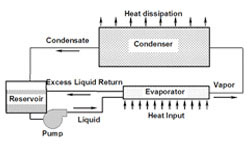how does it work?

Hybrid Two-Phase Loop (HTPL) technology combines the robust operation of mechanically pumped loops with the passive flow control of capillary-driven loops. The concept illustrated in Figure 1 consists of two sub-loops: a mechanically pumped liquid loop and a capillary-driven two-phase loop.
The mechanically pumped liquid loop supplies liquid to the evaporator and returns any excess liquid to the reservoir. The capillary-driven two-phase loop acquires and transports large, high heat flux heat loads through vaporization (evaporator) and condensation (condenser). A capillary structure in the evaporator serves as the interface between the two sub-loops, providing passive control of pressure balance and liquid transport in the system.

Figure 2: A HTPL Evaporator Concept
Figure 2 illustrates a possible HTPL evaporator concept. The liquid is supplied into the evaporator through the liquid dispensers. The evaporator capillary structure is made into porous grooves. The heat input vaporizes the liquid inside the porous lands. The vapor vents into the vapor space above the porous structure, while the excess liquid is collected at the bottoms of the grooves and flows along the grooves toward the reservoir.
Various features of the Hybrid Two-Phase Loop (HTPL) technology are covered by U.S. patents 6,948,556 and 6,990,816 and additional applications by ACT. ACT has applied the Hybrid Two-Phase Loop (HTPL) technology in a number of vehicle, spacecraft, and electronics thermal control applications. Multiple generations of Hybrid Two-Phase Loop (HTPL) have been designed, fabricated and tested to demonstrate the technology performance characteristics. Figure 3 shows a HTPL that has four evaporators each capable of cooling more than 2,500W of heat load.
Demonstrated Performance Characteristics of HTPL Technology

Figure 3: 4-Evaporator HTPL
- High heat flux: tested to 1,200W/cm2
- Heat transport: tested to 4,000W per evaporator
- Cooling of large area heat sources: tested to 135cm2
- Cooling of multiple discrete heat sources: tested to 7 evaporators in one loop, with asymmetric heat loads
- Insensitivity to body force: tested at all gravity orientations and mil-spec shock and vibration conditions
- Flow control: no active control is needed even under varying heat loads and orientations
